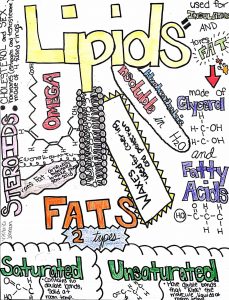
In the past, I’ve had students create concept maps to help them organize the four macromolecules and related details. This year, I modified the assignment to try to encourage the use of sketching to help students remember the details. Students were asked to focus on one of the four macromolecules: lipids, carbohydrates, nucleic acids, or proteins.
To model how sketch notes can be made, I showed them an already completed sketch of proteins and pointed out how the use of color and text size can organize the details. Because students had already seen a sample of the protein sketch, I eliminated that one from the assignment, though I did notice that some students chose to color it and most added it to their folder.
Alternately, you could provide a sample from another topic so that proteins could still be an option. There are several artistic types that have shared biology sketch notes, here’s a whole section on Pinterest.
My students enjoyed this project, and it really didn’t take that long; most reported spending 20-30 minutes on theirs, though it was obvious that some spent more time than others.
The rubric I used to grade their submissions focused on the use of headings (font, size, color), the number of details related to big ideas, the connections between those ideas, and overall creativity. Rubric is included in the file, but I don’t actually print the assignment for students, they can see it on the projector.
HS-LS1-6 Construct and revise an explanation based on evidence for how carbon, hydrogen, and oxygen from sugar molecules may combine with other elements to form amino acids and/or other large carbon-based molecules.

